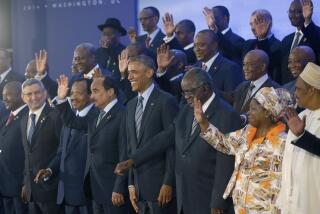Debt Is Enslaving Africa to Global Economic Forces
- Share via
On his tour of Africa last winter Secretary of State George P. Shultz advised African leaders to rely more on market forces to solve their economic problems. But Shultz may be letting ideology get the better of economics by failing to acknowledge basic facts about market forces and the roots of Africa’s economic crisis.
There is certainly need for reform in the economic policies of most African governments. But to lay the blame for economic stagnation solely at their door is to ignore the many obstacles over which Africans have little control: stagnating markets for exports, growing protectionism by industrial countries, and the unwillingness of Western corporate and government leaders to invest capital in Africa.
Over the past 200 years Africa has been integrated into the world economy in a dependent way. Colonial governments first geared African economies for exporting raw materials, mainly minerals and cash crops like coffee, cotton and cocoa. Today 37 countries (with more than 60% of Africa’s population) get more than half their total export earnings from primary commodity exports; for 20 of those countries the figure is close to 100%.
World market prices for raw materials fluctuate more than prices for industrial goods, making reliable economic planning in most of Africa most difficult, if not impossible. Raw-material prices also tend to stagnate or decline over time relative to prices of manufactured goods. All major categories of Third World exports have suffered real price declines during the post-World War II period. Yet prices of manufactured exports from industrial countries have risen steadily, averaging annual real increases of 5.4% from 1965 to 1973 and 11% from 1973 to 1980.
Another factor contributing to Africa’s trade crisis is the changing nature of world industry. Many raw-material exports are being replaced by new synthetic industrial products. For example, artificial sweeteners are steadily replacing sugar; communications equipment that previously required copper wire by the ton now requires only pounds of glass-fiber optics.
These developments have scuttled the simplistic notions of comparative advantage that developed countries used to persuade Third World leaders to keep their economies dependent on exports of raw materials.
Contrary to the free-market policies that Shultz espouses for Africa, the United States and other governments of the Western world have erected protectionist barriers that present a formidable obstacle to Third World competition. According to the World Bank, “The industrial countries have erected high barriers to imports of temperate-zone products from developing countries and then have subsidized their own exports. The special trade preference schemes they have extended to many developing countries have not been a significant offset to their trade restrictions.” Yet 75% of Africa’s total exports go to industrial countries.
Another obstacle to African exports is the concentration of market control in the hands of relatively few transnational corporations. The United Nations Conference on Trade and Development reports that three to six corporations control the following percentages of global trade for each product: 80% to 85% of copper and 90% to 95% of iron ore; 85% to 90% of cotton, wheat, corn, cocoa, coffee and pineapples; 80% of tea; 70% to 75% of bananas; 60% of sugar. Truly free trade is hardly possible when market power is so concentrated.
This combination of factors has plunged African economies deeply into debt. By the end of 1985, sub-Saharan Africa’s external debt was conservatively estimated at well over $100 billion. Latin America’s debt has received more attention because its greater absolute size poses more of a threat to Western banks. But, when measured in terms of human suffering and each country’s inability to repay, Africa’s debt is even more devastating. For many African countries, external debt equals more than 90% of annual gross domestic product.
By 1986 Africans were scheduled to pay $7 billion per year in debt service, representing an average 40% of foreign-exchange earnings. Sudan would have had to pay more than 100% of export earnings in 1985 had it not rescheduled its debt payments. During the first half of the 1980s, two-thirds of the 44 countries in sub-Saharan Africa were forced to seek rescheduling of their debt payments.
While African countries are struggling to make payments on past debt, Western banks are increasingly unwilling to make new loans. In 1980 Africa had a net inflow of nearly $1.5 billion from private creditors. But by 1985 reductions in new private lending, combined with capital flight and debt repayments, made Africa a net loser of $700 million in private capital for the year. The trend is worsening.
The United States alone received $533 million in debt-service payments from African countries in 1984. This money used to be recycled into development funds. Under the Reagan Administration it now goes into general U.S. Treasury funds to help the federal debt.
It is easy for Western leaders like Shultz to advise African governments to put more trust in market forces. But without major structural changes in the international economic institutions that mostly block Third World development, reforms at the national level in Africa can have only a very limited effect.
More to Read
Sign up for Essential California
The most important California stories and recommendations in your inbox every morning.
You may occasionally receive promotional content from the Los Angeles Times.









